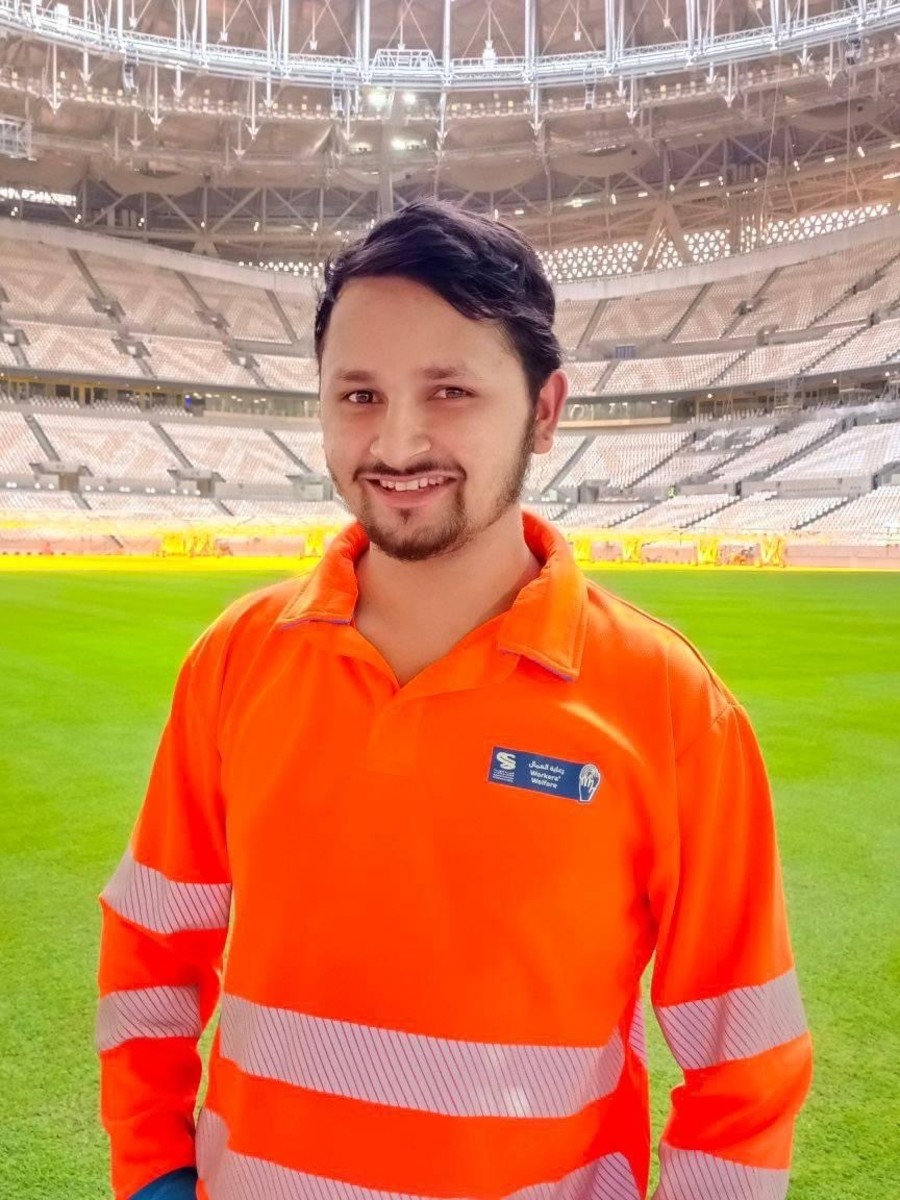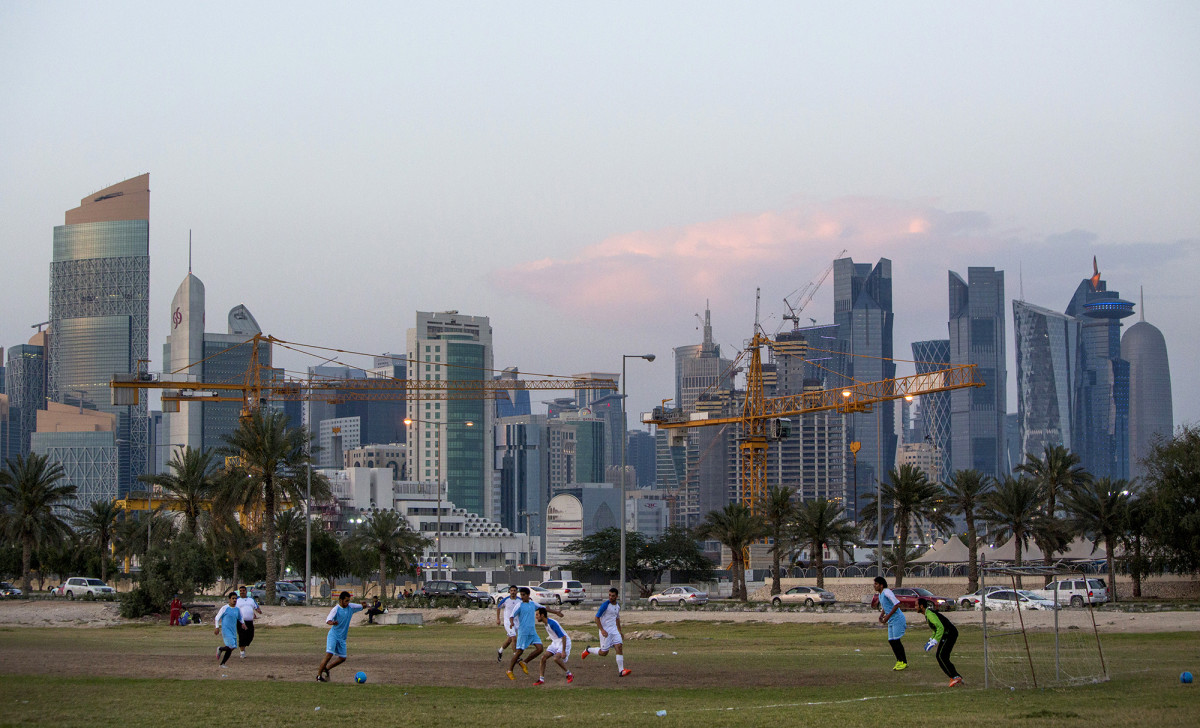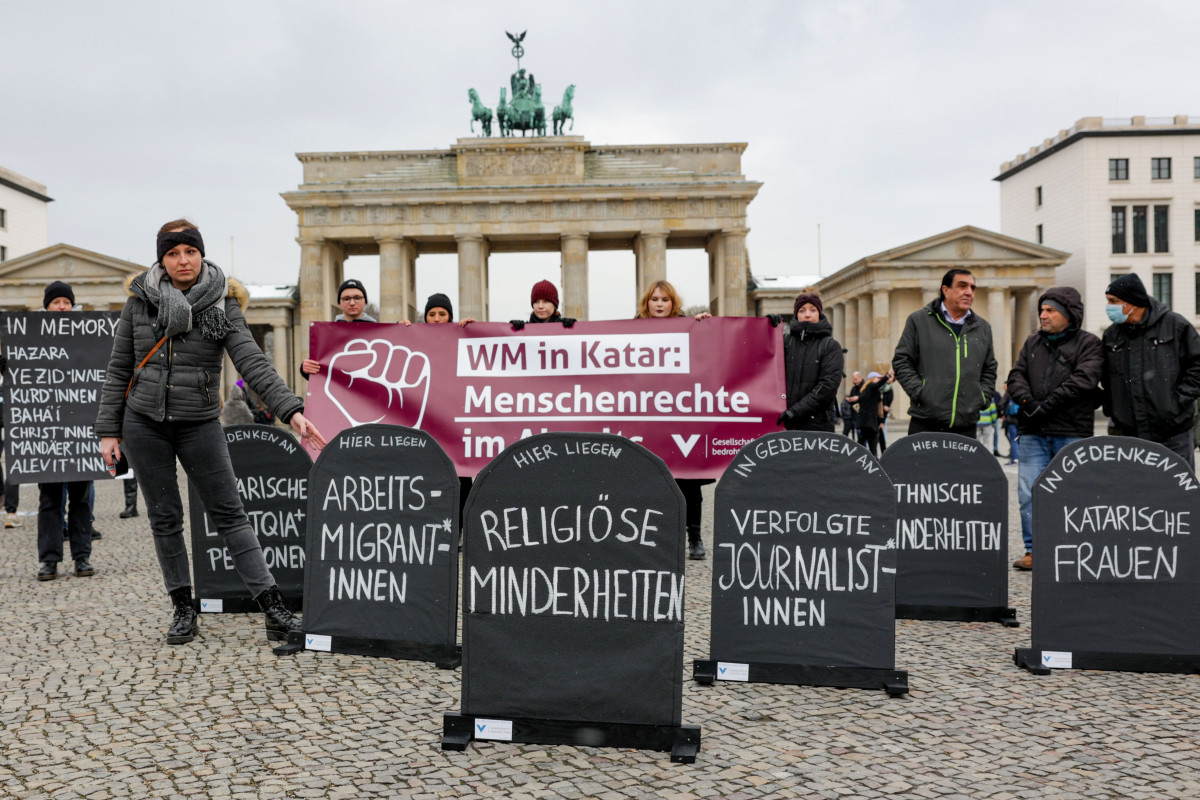In Building This World Cup, They ‘Fulfilled the Beauty of Qatar. But There Is No Happiness For Us.’
In a city that barely existed 10 years ago, towers now compete for size and scope. To be the most lavish, the most expensive, the tallest. They loom, like a forest of steel, curves and ambition. They peer down on fountains and promenades and parks and malls and marinas and hotels, one shaped like a pair of curved swords; everything new, marble, imported. They’re best viewed at night, when they gleam and sparkle from spotlights and neon lights and art displays designed to glow.
On Sunday, the largest sporting event in the world will conclude in Lusail City, which sprouted along Doha’s northern waterfront with singular purpose. It will be held under the largest spotlight imaginable, inside Lusail Iconic Stadium. Argentina versus France. Some will tune in for the soccer, others for country or spectacle or, perhaps, Lionel Messi’s final World Cup match. But above all this, many observers will wrestle with a question that my late friend Grant Wahl first posed eight years ago when he looked at what was developing in Qatar:

Some 2,000 miles away, in Nepal, 26-year-old Anish Adhikari will see a lot of things. That is, if the Wi-Fi cooperates and he can view the final on his cellphone.
He will see the stadium he toiled to construct as a laborer, despite wicked temperatures and abusive bosses. He will see the very thing he imagined in the three years he spent struggling: his soccer hero, Messi, starring in a space that Adhikari helped shape with his own hands, all while 80,000-plus fans scream and billions watch on TV. Him! The kid with so little, who long ago listened to soccer broadcasts on an old radio and dared to envision another life.
Adhikari used to dream about this moment, about sitting in the crowd. As an adult, he grew to see this was impossible, that the years he spent laboring in Qatar were in service of someone else’s dream. He worked because he believed he had no other choice.
Adhikari comes from the eastern part of Nepal, where work is scarce, resources scarcer. His small village in the Khotang district is remote, hills everywhere, which further limited the options for him and his extended family of 14. The family took out a loan—500,000 Indian rupees, or just over $6,000, plus interest—that they had no means of paying back. Someone floated the idea of Adhikari working security in Malaysia, 2,000 miles away, but the gig never materialized.
Adhikari first sought employment in Qatar in 2018. He slept in decrepit housing, and months flew by without a paycheck, so he went home—but he found the situation even more desperate, and he returned to Qatar. Again, to laboring. This time, he says, a recruiter promised a “better” employer—Hamad Bin Khalid Contracting Co., owned by the Qatari royal family—with free housing, actual breaks and humane conditions, plus 900 riyals (roughly $240) per month. Adhikari, with no other options, knew he would accept even before he heard the terms.
He passed a physical fitness test that mainly involved carrying loads across a variety of distances. Then he secured another loan (with an interest rate of 64% in Year 1) to cover migration costs, building his debt to nearly $8,500, altogether. His family’s survival depended entirely on his ability to earn.
But the conditions, he soon found, weren’t better. The water offered at the job was typically 90% ice, 10% water, not enough for everyone to slurp. Adhikari shared a room with four workers and a floor with 80, which meant long lines for just 10 toilets and 10 showers. The air conditioners worked only occasionally. And when workers complained to their bosses about any of this, Adhikari says, they were told they were welcome to leave with their mountains of debt. (HBK Contracting did not respond to Sports Illustrated for comment.)

As the World Cup drew nearer, workers—thousands at Lusail Stadium; tens of thousands across all venues—were increasingly confronted with monitoring teams, who asked them to describe the challenges they faced. But already, Adhikari says, they had been threatened by their bosses with severe repercussions if they described the brutal conditions. When those monitors visited, Adhikari says, supervisors simply moved workers out of view, to other sites. Or, he says, someone would pull a fire alarm, sending everyone home until the inspectors left.
For Adhikari, even if he’d wanted to quit, leaving the company was nearly impossible. His employer held his passport and had him under contract, which ran for two years. (He says he knew of other workers with “continuous,” open-ended terms.) If he left, he would have been without work and without the documents he needed to travel. He didn’t have enough money to fly home, and he hadn’t received all of his salary. The combination essentially stranded him. (In recent years, Qatar has reformed laws around employers holding employees’ passports, but human rights organizations suggest the system remains heavily tilted in favor of employers. Workers often face physical barriers to leaving, such as when they live in remote camps under 24-7 surveillance.)
“Free will is a farce,” says a director at one human rights organization. “It’s like debt bondage.”
Adhikari’s experience was a violation of basic human rights, and, according to many of those human rights groups, it was also typical of migrant workers in the Gulf region—of those who built stadiums in record time and those who fashioned gleaming tower cities like Lusail. Adhikari is proud of that work. Proud of his connection, however trivial, to Messi and the final. “The World Cup is very beautiful,” he says. “And I feel satisfied contributing.”
But when he watches on Sunday, Adhikari will also see abuse, debt, exploitation. And worse. Adhikari worked on a day shift, and over time he says he heard of “several deaths” that happened overnight, workers plummeting from structures, collapsing in exhaustion, being crushed under materials or machines. Eventually, he and his coworkers would figure out who had died based on their cubicles. Adhikari would show up for a morning shift and the dead would be marked by their tidy, cleaned-out spaces.
One day, he says, a Chinese laborer was perched on the top level of the stadium without being properly secured. The worker, he says, fell all the way down and died. A separate laborer fell through a hole in the scaffolding that was used to pass along pipes, electrical wiring and air conditioners. He also died.

If Adhikari watches on Sunday—if the Wi-Fi cooperates—he will try not to think about that too much. But he’ll wonder, because they all wonder, why he hasn’t been paid the money he signed up for, and toiled for, and watched other workers die for.
From each fall, the same thing sticks with Adhikari: “the sound”—of a body colliding with concrete, of bones breaking, of anguished screams.
Why was Qatar granted the World Cup in the first place, back in December 2010? The country presented significant security risks. Its summer temperatures—with a hot-season average of 106° F—threatened the safety of players and the comfort of fans. Qatar criminalized homosexuality and dehumanized women. Its size, comparable to Connecticut’s, was unprecedented. It lacked stadiums and its soccer history was charitably thin.
Why? Money. Twenty-two men held votes in that soccer election. Of them, 15 would eventually be indicted, in either the U.S. or Switzerland; or expelled by the International Olympic Committee or some other governing body; or charged by the ethics committee of FIFA, which oversees the tournament and the coffers that it stuffs every few years.
In the aftermath of that vote, Qatar built and grew, constructed and boomed and swelled, adding towers upon towers, public transportation and hotels and highways and airport extensions. The men who toiled to transform an entire country came mostly from South Asia, and their presence spoke to their utter desperation, the lack of another choice. Qatar promised to rapidly transform and then pulled it off, on the laborers’ backs, evolving from a Gulf Region afterthought to, by some measures, the richest country in the world.
Human rights activists followed this extreme makeover closely. People like Namrata Raju, who grew up in the region, primarily in Oman. Raju, 36, trained as an economist, became an interdisciplinary researcher and worked for the International Labor Organization. Eventually she took employment with Equidem, a nonprofit focused on human and labor rights, and now she’s the group’s India director. As a labor expert she remains closely attuned to Qatar’s history and ambitions, including how the discovery of vast offshore oil reserves in 1971 changed the calculus for the country’s ruling class. Expats quickly descended to manage gas plants and build out everything—medical, education, transportation …
The kafala system—a hierarchical construct prominent in Gulf countries, in which employment is framed as a “sponsorship” and workers hand over official documents like passports to their employers—sped up the overhaul of a country with blistering temperatures, minimal infrastructure and sand stretching for miles in every direction. Albeit at significant human cost. (Some Qatari historians, for what it’s worth, contextualize kafala as a British import that predates the big oil unearthing.)
This infrastructure grew, so the population grew, although the vast majority of those who call Qatar’s borders home came from somewhere else. Of the country’s 2.9 million residents today, just 300,000 are considered official natives. Everyone else needs a work visa, and where they’re from tends to dictate what kind of work they do. Filipinos tend to man coffee shop counters. Indians and Pakistanis tend to drive taxi cabs. Africans tend to work as security guards. Raju calls this a “racialized hierarchy,” operated by an independent nation-state that governs through absolutist monarchy. There’s the ruling class and those who serve them.

Ultimately, growth, wealth and cheap labor netted higher ambitions. Sports became part of the sell, another path to palatability. Workers mattered, but only for what they built. All of this—the history, the oil, kafala, the boom—led to the same place: the World Cup bid.
Despite decades of human rights abuses, despite all the factors that rendered this place a suspect choice, Qatar won. (In April 2020, the U.S. Justice Department alleged that FIFA officials had been bribed.) The tournament was moved to November, a first in the men’s World Cup’s 92-year history. Both host and soccer body said the country would be inclusive, open to all. They said the kafala system was abolished. Among other endorsers, they gave David Beckham $200 million to back their efforts.
By 2017, though, the glare from the international limelight had only intensified. Several neighboring countries, including Saudi Arabia, which shares Qatar’s only land border, put a trade and diplomatic blockade in place, alleging that Qatar supported terrorism. Under severe economic and diplomatic sanctions, Qatari government officials claimed to have overhauled the country’s migrant-labor laws, adding a minimum wage for all workers, among other protections. (The blockade was lifted in ’21.)
As the World Cup drew closer, the messaging never changed. Qatar was growth personified, from a man-made island (which would house the U.S. team) to a stadium built out of shipping containers (which will be taken apart after the tournament). At what cost? More than $200 billion, plus lives shattered and lives lost.
Still, Qatari officials promised to make good with the migrant workers who were owed money. They would open a sort of support center for them, independent of companies and bosses. FIFA czar Gianni Infantino suggested that any aggrieved worker would be able to simply call the authorities and wait for the cash to roll in.
Most, like Adhikari, are still waiting. The few paychecks he did receive for working on the stadium that will host the World Cup final went primarily to the interest on his loans. Eventually, he went back home to that hilly village and that large extended family, now deeper in debt.
Meanwhile, reports suggest the World Cup will generate a record $7.5 billion.
“I will get the money back,” Adhikari says. But he doesn’t sound convinced.
Before migrating to Qatar, Geoffrey Owino says he found his “calling” as a shop steward in his native Kenya. He says he helped form the first private security workers union in his area, which later broadened to include more than 600,000 people.
Then he lost his job. He needed money. In 2018, based on what he says were false promises from a recruiting agent, he went to Qatar, expecting “paradise.” When he arrived and saw his contract, the terms hardly resembled what he’d been promised. But he was, essentially, pot committed, having paid $1,500 for migration fees. At first, on principle, he told his potential new employer to send him back. “This is wrong,” he said. “This is not how it’s supposed to be.”
“My friend, who are you?” came the reply, he says. “You are not special. … We’ve been here for years. Nobody has ever contested this.”
Eventually, Owino, too, relented. But he says he promised that day that when he was done—after he’d earned enough to pay back all that he owed, however long that took—he would make a difference. “I don’t want others to go through what I went through,” he says. “I don’t want another person to be misled.”
Today, back in Kenya, Owino, 40, works as an investigator for Equidem, with a focus on east and central Africa. (He says he was already informally consulting other workers, informally, when he was employed in Qatar.) He gets fewer than four hours of sleep each night, with the weight of the work piling up. As he speaks on an encrypted call he has some 3,700 WhatsApp messages awaiting his reply, each from a migrant worker or their family, desperate, with nowhere else to turn. “There is nobody,” he says, “to speak for them.”
In a life devoid of typical days, he says he typically tries to respond to anywhere between 300 and 500 messages, mostly from nervous and aggrieved laborers who have been injured on the job or are owed money, weighing whether there’s an investigation to pursue. Sometimes, he has to physically separate himself from his phone, such is the stress.
Owino is narrow in his definition of success in this space. There will always be more people, more lawsuits, more hardships, more deaths. Every win counts. But the losses do not count, because that count would be too high, too demoralizing. Losses must be accepted as a reality. Like the woman he tried to help in Qatar recently who said that after arriving as a migrant worker she was assaulted by a police officer, only to find out later that the case was dismissed. (The woman’s lawyer told Owino, “There are some people here who are special,” meaning privileged, or, in some instances, above reproach. Says Owino: “It’s quite disheartening.”)
On this particular afternoon, Owino plans to turn off his phone and watch Argentina’s World Cup semifinal clash with Croatia. In past years he has watched every single match. In this tournament, though, it’s been far less.
“I just need to shutter my mind, think of something different,” he says. “Sometimes I still see the memories. Extreme conditions. People passing out. That passion is no longer there.”
The life of Tarakul Sumon, a migrant worker who four years ago arrived in Qatar from Bangladesh, is now reduced to a series of forms. Sequences of letters and numbers—visa number, job application number, passport number, mobile number—that mean nothing and everything all at once.
The documents, shared by his family, show his path into Qatar’s labor market. His appointment letter confirms that he paid a Visa fee of 137 riyals ($36). It includes instructions on where he was supposed to go upon arrival (to the Qatar Visitor Center), what to bring (his documents, to hand over) and what happens next (fingerprints, iris scan, facial capture, contract signing, medical exam …).
He did all that, the documents show, netting a job as a laborer and a residency permit, good until May 10, 2020. There’s nothing in the file about his job—whether he was good at it or the conditions he worked in. The documents skip right to the end. A notification of his dying, at 26. A death certificate, dated April 13, 2020, where the cause is listed as CRUSH HEAD INJURY TWO FORCES IMPACT. Dated six months later, an embalming and sealing certificate, which confirms that “the body … has been completely embalmed and will be free from decomposition for a period of one week. … The body is placed in a metal container which has been completely sealed and is airtight.”
Then the bill, the cost of transporting the body of a migrant worker 4,000 miles, to his family. It doesn’t matter anymore that Sumon was owed money when he died. The price of his return, the equivalent of $2,300, was covered by the Bangladeshi government. (His employer, listed as Sollass for Glass and Aluminum on the documents, filed an insurance claim on Sumon in March 2021 for more than $50,000. Attempts to reach Sollass for comment were unsuccessful.)

Sundor shakes his head. He’s wearing a white sweatshirt with USA stamped across the front, and his long goatee is dyed bright orange. He says that his only son—he also has two daughters—worked in a Qatari factory that produced glass, aluminum and other “fancy” materials for World Cup stadiums. He says he has filed a complaint over the handling of his son’s death with the Wage Earner’s Welfare Bureau of Bangladesh. At the same time, Sundor is dealing with heart disease. His wife has cancer. He worries about his daughters and how they will pay for schooling. His son, having earned a college degree in computer science, was meant to be the family breadwinner. But Tarakul couldn’t find work, so he migrated to Qatar.
“He [had] no other option,” Sundor says. “What causes humanity to have no other option?” He scoffs. “Yeah. Money.”
The tireless work of investigators like Owino and, in the case of Sumon, Bangladesh-based researcher Eiffel Abedin, helped shape an 18-month investigation into the working conditions for migrant laborers in Qatar in advance of the World Cup. That 113-page report, titled “If We Complain, We Are Fired,” identified real people and their families and their grievances. It also revealed case after case of money that’s still owed.
Equidem’s researchers spoke to nearly 1,000 migrant workers and found complaints ranging from wage theft to nationality-based discrimination to overwork to abuse. The laborers feared reprisal from their bosses. Many were scared of their employers and of the government. Some didn’t receive their monthly salaries. Some never got their end-of-service benefits. Some arrived to find contracts for less money than originally offered, a tactic known as contract substitution. Most were not paid their recruitment fees, which, Raju notes, are the responsibility of their employees, per Qatari law. The network of recruiting agencies and agents in developing countries is vast, according to Raju and others; some aren’t even licensed, and no vetting process exists.
“That’s the biggest loophole that we have repeatedly found,” Raju says. “That carrying out things in practice doesn’t occur. … A lot of companies are not even abiding by laws and policies that Qatar has laid down.” (In response to a Rolling Stone story about Equidem’s work and allegations, a Qatari government representative pointed to “bad-faith” and “substandard contractors” and praised the country’s “comprehensive labor reform package,” including the new minimum wage, as well as various inspections and awareness campaigns around new labor laws.)
Emran Khan, a migrant worker from Bangladesh who now works for a local workers’ rights organization, takes this all in and feels mostly anger, mixed with sadness. “It’s very painful,” he says. “At the end of the day, we’re human beings. We fulfilled the beauty of Qatar, with our hands—with my hands. But there is no happiness for us. None.”

The so-called “white elephant” is a staple of the 21st-century international sporting event. Usually that means a stadium or stadiums that, while full and glimmering for a few weeks, later sit empty. But in Qatar, for this World Cup, the white elephants are the workers—especially those still owed money—who are forgotten as soon as the final ends. And those are the ones who lived.
And so: A globe of soccer obsessives now prepares to close out a World Cup for which, according to The Guardian, some 6,500 migrant workers have died since Qatar won the right to host—with 40 of those deaths tied specifically to stadium construction. (Amnesty International notes that up to 70% of the deaths tied to World Cup preparation were not investigated in the proper manner.)
Qatari officials, meanwhile, continue to thump their chests about the first World Cup hosted in the Middle East, citing a “historic” tournament and seemingly altered perceptions, which they believe will yield additional tourist interest and dollars. (There’s even talk about a cross-continental World Cup bid that would return the tournament to the region in the next decade.) The infrastructure added over the past decade, piled onto the riches from vast natural gas reserves, will leave Qatar more livable, more visitable than ever before. That’s the official sell, at least, though it’s more like a hope. Or elite sportswashing.
What’s the legacy of this one month of winter soccer? Follow the money. The trail leads away from those who made the games possible, who built the structures, and right to those who profit from them. Cash is taken from the migrant workers, who have no seat at the table, no agency. It goes to the Qatari government, to FIFA and its sponsors. It’s possible to enjoy the soccer, but only with this context. The cost.
Legacy? Owino, the Kenyan case collector, wants healing for the workers who bombard his inbox with the saddest stories in the world. He wants those who made the stadiums to be paid for the work they did and the risks they took, for what they survived. He wants the soccer organizations who “talk tough” to be less “sinister and toothless.” He doesn’t want other countries to see Qatar’s financial success and think they can abuse workers to bank billions.
Legacy? It depends on who you think this World Cup is for. The overlords, with their cash machines? The workers, with their scars? The soccer fans, caught in the middle?
Opulence comes at a price. Still, Equidem, and all those seeking justice, will try to move forward, to seek compensation. “At the end of the day,” Raju says, “the reason I do this work is because I still have hope.”
